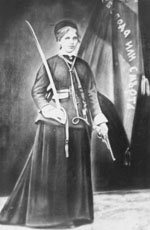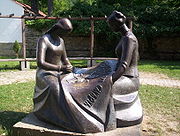
Rayna Knyaginya
Encyclopedia


Knyaz
Kniaz, knyaz or knez is a Slavic title found in most Slavic languages, denoting a royal nobility rank. It is usually translated into English as either Prince or less commonly as Duke....
(Райна Княгиня) (1856-1917) was a Bulgaria
Bulgaria
Bulgaria , officially the Republic of Bulgaria , is a parliamentary democracy within a unitary constitutional republic in Southeast Europe. The country borders Romania to the north, Serbia and Macedonia to the west, Greece and Turkey to the south, as well as the Black Sea to the east...
n teacher and revolutionary born in Panagyurishte
Panagyurishte
Panagyurishte is a town in Pazardzhik Province, Southern Bulgaria, situated in a small valley in the Sredna Gora mountains. It is 91 km east of Sofia, 43 km north of Pazardzhik, and 37 km south of Zlatitsa. The town is the administrative centre of the homonymous Panagyurishte...
who is famous for having sewn the flag of the April Uprising
April Uprising
The April Uprising was an insurrection organised by the Bulgarians in the Ottoman Empire from April to May 1876, which indirectly resulted in the re-establishment of Bulgaria as an autonomous nation in 1878...
of 1876.
The flag and the uprising
When she was 20 and working as a head teacher in the Panagyurishte girls' school, she was asked to sew the flag for the April Uprising by Georgi Benkovski, which she accepted. The lion on the flag was drawn by Stoyan "Banenetsa" Karaleev after the pattern of the lion printed on the cover of the Bulgarian Revolutionary Central CommitteeBulgarian Revolutionary Central Committee
The Bulgarian Revolutionary Central Committee or BRCK was a Bulgarian revolutionary organisation founded in 1869 among the Bulgarian emigrant circles in Romania. The decisive influence for the establishment of the committee was exerted by the Svoboda newspaper which Lyuben Karavelov began to...
's organization chart and the letters were drawn by Ivancho Zografa. Besides the Свобода или смърт (Svoboda ili smart, Freedom or death) inscription, the letters П and О (standing for Панагюрски окръг, the Panagyurishte revolutionary district) were added at the bottom.
On 22 April, the day of the flag's sanctification by priests from neighbouring villages, Rayna sewed tassel
Tassel
A tassel is a finishing feature in fabric decoration. It is a universal ornament that is seen in varying versions in many cultures around the globe.-Etymology:...
s prepared during the night to it. The flag's size is 2 by 1.5 m, it has two sides and is hemmed by a strip of gold lace.
On the day the uprising was proclaimed, she waved the flag together with Georgi Benkovski. After it was brutally crushed by Ottoman
Ottoman Empire
The Ottoman EmpireIt was usually referred to as the "Ottoman Empire", the "Turkish Empire", the "Ottoman Caliphate" or more commonly "Turkey" by its contemporaries...
troops, she was captured, beaten and allowed only to eat bread and water for more than a month in the Plovdiv
Plovdiv
Plovdiv is the second-largest city in Bulgaria after Sofia with a population of 338,153 inhabitants according to Census 2011. Plovdiv's history spans some 6,000 years, with traces of a Neolithic settlement dating to roughly 4000 BC; it is one of the oldest cities in Europe...
prison.
For the commemoration of the uprising's 25th anniversary, Rayna Knyaginya prepared three copies of the original flag, two of them surviving until today and the other one being destroyed during the bombings of Sofia in World War II
World War II
World War II, or the Second World War , was a global conflict lasting from 1939 to 1945, involving most of the world's nations—including all of the great powers—eventually forming two opposing military alliances: the Allies and the Axis...
.

Later life
After her time in the prison, she managed to reach MoscowMoscow
Moscow is the capital, the most populous city, and the most populous federal subject of Russia. The city is a major political, economic, cultural, scientific, religious, financial, educational, and transportation centre of Russia and the continent...
through Istanbul
Istanbul
Istanbul , historically known as Byzantium and Constantinople , is the largest city of Turkey. Istanbul metropolitan province had 13.26 million people living in it as of December, 2010, which is 18% of Turkey's population and the 3rd largest metropolitan area in Europe after London and...
with a forged passport, where she studied medicine for three years and became a maternity nurse. There she wrote her autobiography, the first book about the uprising, that was first published in Russian
Russian language
Russian is a Slavic language used primarily in Russia, Belarus, Uzbekistan, Kazakhstan, Tajikistan and Kyrgyzstan. It is an unofficial but widely spoken language in Ukraine, Moldova, Latvia, Turkmenistan and Estonia and, to a lesser extent, the other countries that were once constituent republics...
and translated to Bulgarian
Bulgarian language
Bulgarian is an Indo-European language, a member of the Slavic linguistic group.Bulgarian, along with the closely related Macedonian language, demonstrates several linguistic characteristics that set it apart from all other Slavic languages such as the elimination of case declension, the...
in 1934. While in Moscow, she managed to arrange the upbringing of 32 orphans from Panagyurishte, including her younger brother, through a ladies' charity committee.
Rayna Knyaginya was then invited by Kliment Turnovski
Kliment Turnovski
Kliment Turnovski, , was a leading Bulgarian clergyman and politician...
to become a teacher in Tarnovo. She returned to Panagyurishte three years later to marry Vasil Dipchev, the mayor of the town. They moved to Plovdiv, where Dipchev, an extreme russophile
Russophile
Russophile may refer to:* Russophilia, the love of Russia or Russians* Ukrainian Russophiles, a Ukrainian cultural faction in nineteenth and early twentieth century Galicia who espoused Ruthenian autonomy...
, was unable to find a job during the russophobic government of Stefan Stambolov
Stefan Stambolov
Stefan Nikolov Stambolov was a Bulgarian politician, who served as Prime Minister and regent. He is considered one of the most important and popular "Founders of Modern Bulgaria", and is sometimes referred to as "the Bulgarian Bismarck".- Early years :Stambolov was born in Veliko Tarnovo...
.
The two had five sons — Ivan, Georgi, Vladimir, Petar and Asen. Rayna also adopted a girl by the name of Gina. Vasil Dipchev was elected a deputy to the National Assembly of Bulgaria
National Assembly of Bulgaria
The National Assembly of Bulgaria is the unicameral parliament and body of the legislative of the Republic of Bulgaria.The National Assembly of Bulgaria was established in 1879 with the Constitution of Bulgaria.-Ordinary National Assembly:...
in 1888 and the family moved to Sofia
Sofia
Sofia is the capital and largest city of Bulgaria and the 12th largest city in the European Union with a population of 1.27 million people. It is located in western Bulgaria, at the foot of Mount Vitosha and approximately at the centre of the Balkan Peninsula.Prehistoric settlements were excavated...
. Dipchev died in 1898 as a consequence of the Black Mosque
Sveti Sedmochislenitsi Church
The Sveti Sedmochislenitsi Church is a Bulgarian Orthodox church in Sofia, the capital of Bulgaria. It was created between 1901 and 1902 through the conversion of an abandoned Ottoman mosque, and was inaugurated on 27 July 1903...
beatings that followed the assault on Stambolov, leaving Rayna with six children, the oldest of which was only 13 years old. She worked in the Sofia quarters of Orlandovtsi and Malashevtsi, maintaining strong ties with the family of Hristo Botev
Hristo Botev
Hristo Botev , born Hristo Botyov Petkov , was a Bulgarian poet and national revolutionary. Botev is widely considered by Bulgarians to be a symbolic historical figure and national hero.-Early years:...
until her death on 29 July 1917, then 61 years old.
Honour
- Rayna Knyaginya PeakRayna Knyaginya PeakRayna Knyaginya Peak is a peak of elevation 680 m in western Bowles Ridge, Livingston Island in the South Shetland Islands, Antarctica...
, a peak on Livingston Island in Antarctica is named after her.
External links
- A collection of Bulgarian folk songs dedicated to Rayna Knyaginya at Liternet.bg (in Bulgarian)
- The descendants of Rayna Knyaginya (in Bulgarian)

